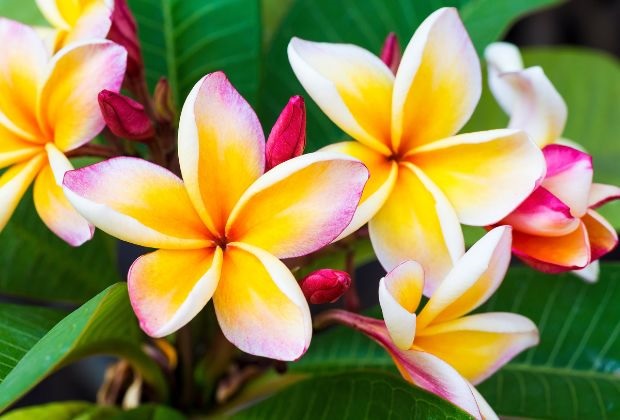The plumeria flower—scientifically known as the frangipani—is one of nature’s many marvels. It’s a tropical bloom that features a natural ombre that darkens toward the center and, in some color variations, along the outer edges of the petals. Plumerias also provide a rich floral fragrance, thick petals, and lots of cultural importance. Interested to learn more about this mysteriously beautiful piece of nature? Read on to learn more about what makes the plumeria flower so significant.

Devotion to the Fragility of Human Life
Most people enjoy flowers for their beauty; however, plumerias are far more beautiful and sacred compared to most common daises or roses. In fact, plumerias’ appearance represents the beauty of life. Some people even say that the natural color gradient embodies the journey of one’s life. The color transitions symbolize the end, the beginning, and immortality. However, plumerias are also highly toxic plants. The center and roots of plumerias are death—literally.
With both beauty and toxicity, these flowers embody the fragility of life, a key aspect of many devotional beliefs. In India, Sri Lanka, Thailand, and other Buddhist and Hindu-centered communities, the plumeria is known as the temple flower. They are commonly found flourishing around the grounds of a sacred space.
Gifts to the Graveyard
There are many reasons why it’s important to send flowers to a funeral, from the conveyance of love to the creation of a balance between beauty and death. In fact, many cultures bury their loved ones alongside flowers.
If you travel to Singapore, Brunei, Indonesia, and Malaysia, it’s likely you’ll come across plumeria plants as you pass by cemeteries. Plumeria’s ties with life and death, visual appeal, and representation of devotion to life make it a common graveyard flower. However, many also plant them near their loved ones as a means of protection—a trickery for evil spirits. The idea is that the beauty of the plant’s petals will attract evil spirits, but once they take a bite or touch it, the plant’s toxicity will kill them.
Romantic Representation
Flowers are commonly used to express love or romantic interest. However, plumerias symbolize romance, beauty, and grace far more vividly. In Hawaii and other Polynesian islands, women traditionally wear plumerias above their ears to signify their relationship status. Flowers worn behind the left ear represent someone in a relationship. However, when plumerias are worn behind the right ear, they signify that the person is single and open to love.
Plumerias also represent new life and are a common means of congratulating those beginning a new chapter, making them a popular wedding ornament. Regardless of whether you use these flowers for weddings, romance, or any other celebratory event, plumerias are a simple and powerful symbol of love.
Plants carry many meanings and perform various functions, filling nature with an abundance of wonders. Beyond the plants that are good for home purification and mental health boosts, many herbs carry medicinal properties. There are endless wonders and uses we continue to assign to different plants and flowers in nature. And as we learned in this post, some plants have a lot of significance. The plumeria flower is one such plant, taking on various roles in different communities by representing what is essential to humankind.
 World inside pictures Collect and share the best ideas that make our life easier
World inside pictures Collect and share the best ideas that make our life easier






